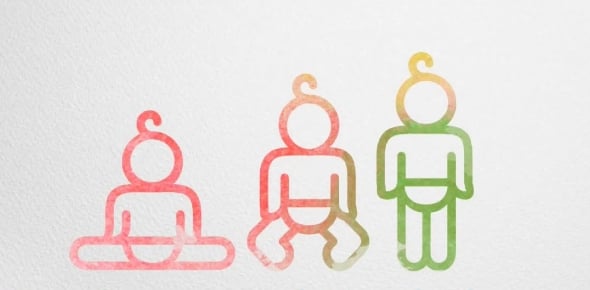Some sample temperament dimensions:
Parenting varies along two separate dimensions.
____________________________ temperament: positive mood and adaptable.
Temperament style influences ability to regulate emotions.
Children who explore freely in caregiver's presence, are often...
Friendships start as early as 2 years of age.
____________________________: an infant's response to unfamiliar...
The prenatal period from the ninth week until birth is...
____________________________ temperament: negative mood, unadaptable,...
Parents who are warm and responsive to their child's needs are...
____________________________ (12 - 18 yrs.): identity development,...
__________________________: an infantile reflex in which an infant...
People who have successful friendships...
According to Piaget, children in the preoperational period of...
__________________________: the conviction that an object exists even...
__________________________: environmental factors that can disrupt...
____________________________ (birth - 18 months): forming attachment...
__________________________: an infantile reflex in which an infant...
__________________________: the fertilized egg, formed by the union of...
____________________________: an infant's response to being away...
Lead, alcohol, and cigarette smoke are all examples...
According to Piaget, the period of cognitive development between birth...
____________________________: a parenting style that is high on...
According to Piaget, the period of cognitive development between ~2...
When an infant looks at a rattle, he is aware of looking at the rattle...
__________________________: the social status status of children who...
Temperament types:
Samuel didn't know how to react to the neighbor's dog, so he...
__________________________: a developmental disorder that affects...
____________________________ (18 - 35 yrs): love and relationships
Rejected children are ____________________________.
____________________________: a parenting style that is low on both...
__________________________: the period of physical and sexual...
____________________________: the strong, enduring, emotional bond...
__________________________: the tubular structure formed early in the...
Development seems to be much more ____________________________...
Research has found that children pass different conservation...
"Who do you like the least?" is...
__________________________: objects are capable of actions and have...
__________________________: the social status of children who are not...
2-year-old Josh has learned the schema for "helicopter" from...
A child exhibits the ability to think abstractly and is proficient at...
____________________________ parenting is the most adaptive parenting...
"Who do you like the most?" is...
____________________________: a parenting style that is low on...
According to Kohlberg, an individual who focuses primarily on getting...
The third through eighth week of prenatal development is called...
Newborns have fairly advanced sensory capacities.
Facial, pubic, and underarm hair are all examples...
The blastocyst attaches itself to the uterine wall and is...
An infant's temperament is ____________________________...
A child exhibits egocentrism and animism. This child understands...
_______________________: a type of insecure attachment where the child...
______________________: inability to distinguish between perspective...
According to Kohlberg, an individual focused primarily on universal...
According to Piaget, the period of cognitive development beyond ~12...
Egocentrism and animism occur in...
____________________________: a process of using others' facial...
____________________________: an experimental procedure for assessing...
__________________________: in Piaget's theory, the developing...
A child does not exhibit an understanding of object permanence....
____________________________ (35 - 60 yrs.): having children,...
_______________________: a type of insecure attachment where there is...
According to Kohlberg, an individual focused primarily on following...
____________________________ proposed the psychosocial theory of...
__________________________: connects the placenta and the embryo....
____________________________ parenting is the worst parenting style.
____________________________ proposed a 6 stage theory of moral...
Development is invariant and universal.
____________________________ (60+ yrs.): imparting wisdom, reflecting...
____________________________ (18 months - 3 yrs.): asserting will and...
____________________________: a parenting style that is high on both...
2-year-old Josh has learned the schema for "helicopter" from...
According to Piaget, the period of cognitive development between ~7...
__________________________: connects the embryo to the uterine wall.
Parenting style classifications:
____________________________: data that describes how individuals in a...
6-month-old infants get habituated (and thus, look less) after being...
Three types of cells result from differentiation:
Categories of peer acceptance.
A child exhibits the ability to classify on multiple dimensions (size,...
Children are, generally, much more ____________________________...
____________________________ temperament. slow to adapt and low...
A child watches as the experimenter makes the teddy bear...
Generally, teratogens are most harmful...
____________________________: individual differences in emotional and...
____________________________: in Piaget's theory, the period from...
____________________________ (6 - 12 yrs.): competencies and...
By showing infants impossible events, it becomes evident...
Girls have ____________________________ relationships with their...
Boys have ____________________________ relationships with their...
Stages of psychosocial development:
____________________________: the set of interrelated concepts we use...
____________________________: in Piaget's theory, the period from...
____________________________ (3 - 6 yrs.): engaging and purposive,...
Infants are capable of doing simple math.
__________________________: In Piaget's theory, the developing...
During conception, cells (the zygote) divide repeatedly. This produces...
__________________________: in an infant, the sucking elicited by...
____________________________: in Piaget's theory, the period from...
____________________________: according to Kohlberg, the first and...
_______________________: a type of insecure attachment where the child...
____________________________: according to Kohlberg, the third and...
__________________________: bodily structures that change with sexual...
__________________________: bodily structures directly related to...
In a more recent study of egocentrism, children of 3 years of age were...
__________________________ serve(s) an important function in...
The heart begins to beat during __________________________.
__________________________: in Piaget's theory, the period of...
Insecure attachment:
____________________________: a method for studying infant perception....
____________________________: according to John Bowlby, the...
____________________________: according to Kohlberg, the fifth and...
These emotional expressions are not present immediately (or shortly...
____________________________: a set of beliefs and expectations about...
















